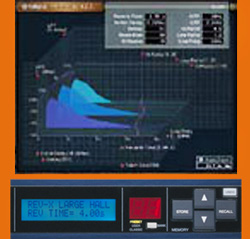Selecting Presets
After the levels are set, it is time to choose a preset. For most vocal situations, a hall or plate reverb is preferred.
Usually, the manufacturer provides a broad palette of presets with descriptive names such as “bright vocal plate” and “rich hall.”
The best way to choose a setting is to align the preset’s title with the singer’s voice character and the song’s musical density. For example, a soloist accompanied by piano benefits from a thick reverb layered with doubling delay to add depth to the voice.
However, if the song is highly orchestrated, a thinner, brighter preset will allow the voice to cut through the mix without resorting to an increase in volume.
Once the processor’s output is routed back to an input on the console, the question of how much reverb is appropriate arises. The short answer is, if the effect is discernable as a distinct entity, its level is too high. Reverb and delay, aside from long delays used as repeats, need to remain below the primary signal level. Reverb should only be noticed in its absence.
Short delays, below 80 milliseconds (ms), are effective bolstering devices, especially useful in solo or duet situations. Doubling, comping, and tracking are terms used to describe a short delay indistinguishable as a separate signal.
Long delays, up to several seconds, are practical for repeats generated in sync with the song’s tempo. However, delays should be used sparingly to avoid drawing attention away from the song. Tapped delays are aligned via a simple front-panel trigger that is tapped in time with the tempo.
Once generated, taps can be brought in and out on the console’s return channel. If the drummer uses a click track, the click can be routed to the front of house console and used as the timing reference to assure proper synchronization from the first downbeat.
Once a preset is selected, it can be altered to taste. Most processors set aside a bank of open user presets where edited versions can be stored. The tedious process of creating a patch from scratch can be avoided by starting with something close to the desired result.
Typical adjustable parameters include reverb time (RT60), pre-delay (initial reflections), damping (high frequency roll-off), and routing scheme (what goes where in the chain).
Full display LCD panels are easier to navigate than limited LEDs whose cryptic codes require the use of a deciphering key. Advanced models sport a compare feature to allow evaluation between the original setting and the altered version.
In use, effects should only be brought to bear on the mix after the fundamentals are firmly in place. A great snare verb is useless if the vocals are muddy.
In rehearsal, the effects should be muted until the mix is clean and clear. Then, reverb can be added to the primary vocals, followed by the BGVs (background vocals) and then the instruments, starting with the snare. During the performance, effects should be turned off between songs to keep speech patter intelligible and levels should be tracked to the ebb and flow of the songs.
Despite vocalists’ objections, effects should be kept out of the stage monitors since reverb and delay mask time and pitch references that are the reason monitors exist. In drama, effects can be used to create James Earl Jones-esque commanding vocals to convey authority. While reverb is not used in speech reinforcement, the occasional doubling effect delay can be included when the orator needs some help with their tonal character.
When misused, effects represent ear candy. However, when thoughtfully applied, they can raise a mix beyond the ordinary to a professional plane. Judiciously layered reverbs and delays thicken and sweeten the mix just as a well-blended icing crowns a perfectly baked cake.
Turning an effects toy into a tool is simply a matter of getting the vocals clean and tight and then adding a sprinkle and dash of effects to take them over the top.
Kent Morris is recognized for his church sound training abilities. He has more than 30 years of experience working with A/V, has served as a sound mixer for several noted performers and is a product development consultant for several leading audio manufacturers.





